We talk a lot, as professional development coordinators and as educators, about self-direction. We think a lot about ways to support self-directed learners, offering them “choice and voice” while trying to make sure we support them in their learning. (And hey, educators, you’re learners too. I’m a learner. We are all, to some degree, self-directed learners).

A brief history of self-directed learning
I started to become familiar with the phrases “self-direction” and “self-directed learning” probably around 2014 or so. I started to hear it in mission statements in, from schools, when they talked about their aspirations. I started to hear it as an outcome for dispositions and skills that we wanted our K-12 learners to have.
And I was really curious about that.
When we in Vermont started to transition towards a personalized learning environment that included proficiency-based learning, the Vermont Agency of Education identified what many of us know as the five Transferable Skills:
- Clear and Effective Communication
- Creative and Practical Problem-Solving
- Informed and Integrative Thinking
- Responsible and Involved Citizenship
- Self-Direction
Most of those felt familiar to me as an educator, but self-direction? That was new. And I didn’t understand what was. What was that as an outcome for students?
Fast forward a few more years. And I start to see Self-Direction on report cards.
I see it in report cards of schools that I’m working with as a professional development coordinator. And I see it on my kids’ report cards, who are adolescent learners themselves.
And basically, I’ve devoted a few years to studying this phenomenon because I feel like there’s some misconceptions about self-direction and self-directed learning.
Where did self-direction come from?
It turns out self-direction is originally an adult learning concept.
It came from theorists and researchers in the sixties and seventies who were interested in how adults pursued further education. That might be adults who never graduated from high school and then decided to pursue a GED. Or they might’ve been adults who are taking night classes.
We’ve taken most of that adult concept and applied it to a K-12 environment. And it’s not a neat and tidy fit.
So I want us to think about what we know about self-direction already. And I want to share some of the things that I learned, which I feel are really of primary importance.
Debunking self-directed learning myths
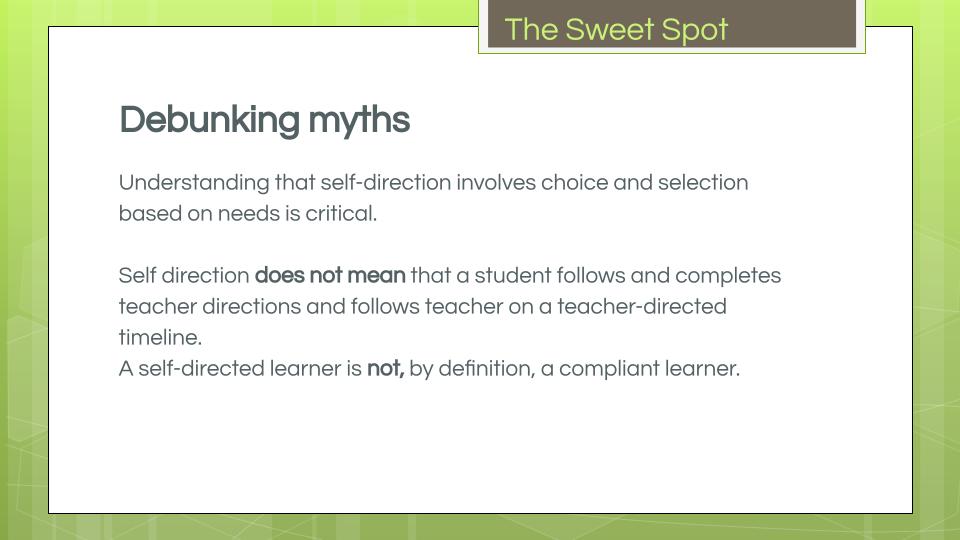
Self-direction needs to have an environment that is supportive of demonstrating skill and exercising that skill.
And that means that students have some degree of autonomy and independence. They are provided with choices and selections that are based on what they know about themselves. That are based on what they know about themselves as learners, and based on their interests and what they know about that.
Self-direction does not mean that a student in a K-12 environment is following directions created by the teacher. Self-direction is not turning in an assignment on time.
Now there’s a little bit of that that’s debatable, right? But self-direction really has this degree to which it’s about the student identifying what they have for goals and their ability to pursue those goals.
So when we see this talked about in schools, particularly in younger cases where students maybe don’t have a lot of opportunities for self-direction, sometimes it’s being defined in schools as the way a child follows teacher directions.
And that could not be more of a myth self-direction.
Self-direction doesn’t always look like compliance. In fact, sometimes our most self-directed kids are our least compliant kids!
So I just want to give you an opportunity to think about that and think about how that concept of self-direction as compliance might impact your previous knowledge about self-directed learning.
In the last few years, we’ve seen a lot of information coming out of research sites that are supporting the schools and the teachers that are really trying to invest and move the self-direction skills of their students.
Dimensions of self-directed learning
Here’s an example of what has been pretty widely agreed upon as five dimensions of self-direction.
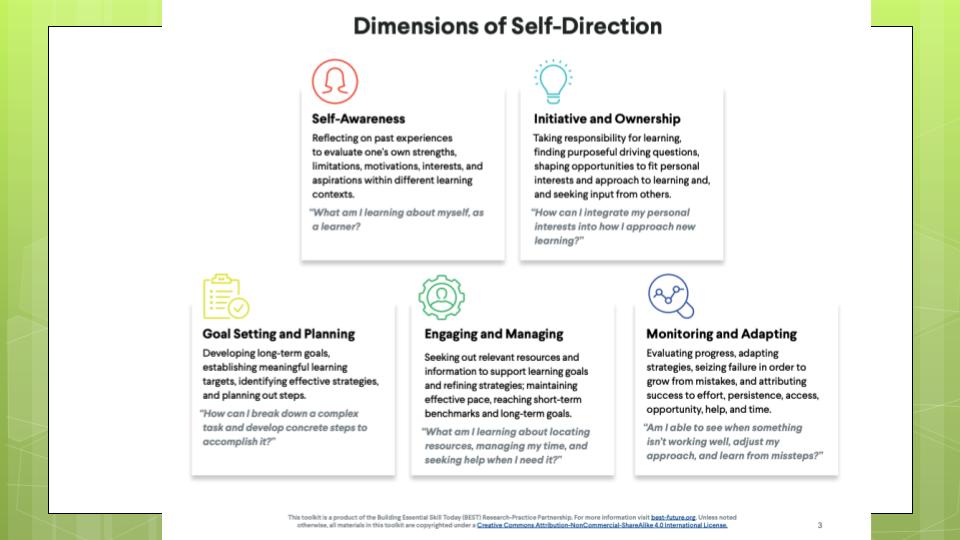
This mimics what I’ve seen in a couple of other toolkits, but this comes from a group called the Research-Practice Partnership (.pdf).
And this is the same as the essential skills and dispositions, which some of you might be familiar with, but these five things are what have been identified in the research as the effective dimensions of self-direction.
And so what I hope to do is engage you in an exploration of what do these things look like in your practice.
Most importantly:
- Where are you giving your students opportunities to practice and demonstrate and engage in these skills?
- And then how are you supporting them?
Scaffolding self-directed learners at different ages
Because what we know about self-direction is that to some degree, like a lot of skills, we have people who, for whatever reason, have a little bit more of it than others.
Let’s take like maybe a fourth or fifth grader.
There’s definitely differences at that stage about what students have for self-direction skills, but somewhere along the line, that student had experiences or guidance that helped shape them, right?
Maybe it was a parent at home, maybe it was an experience in summer camp, but they’ve got a little bit of self-direction. But when students don’t have self-direction, we need to coach them and provide them with the scaffolds to develop it.
One of the things I like to remind people about is that when you see a kindergartener enter into a building, and enter into our school system, they have a lot of these things. They have a lot of questions. And they can take initiative. They’re curious. They can identify things they want to learn about.
And then somewhere in our K to 12 spectrum, sometimes some of our learners don’t continue to have opportunities to exercise self-direction.
I think about it as like a muscle.
If you come into kindergarten with these muscles, but no one gives you an opportunity to exercise them and work out, they atrophy. They weaken. And that’s why we sometimes see self-direction failing when we attempt it too late in the process.
You ask eighth graders,“What do you want to learn about, kids? What do you know about yourself?”
And they look at you with blank stares. They say,
“I don’t know, why are you asking me this all of a sudden?”
So self-direction is a process we’re trying to help you develop in your learners. And help you develop the routines and the structures that we think help move this skill in students. When we talk about these things, it’s super complex. And that really fascinates me because it involves so many different parts of learning and education. There’s a lot of human behavior and psychology within this.
And in this course we’re offering, you might choose to just investigate one of these dimensions and how you can create structures and supports for your students to develop that one dimension.
Analyzing self-direction in the classroom
Watch this video.

And as you watch this video, ask yourself: what does self-direction look like for some of these students?
And more importantly, I want you to focus on the educators. What are the scaffolds or supports that you see being put in place for these learners in that video?
Personally, I saw a lot of things.
I saw teachers providing templates and project plans.
I noticed that students had a journal where they were reflecting on both their plan and how it worked.
And I heard that teacher asking a student what the student needed to do and what they thought.
I also saw a process or a system in place where students used each other as resources.
I think this video gives us a great example of self-direction in a classroom and what teachers can do to develop it.
“The Dark Side of Self-Direction”
I don’t think there really is a dark side, per se, but what I mean by that is that it’s clear to me that we do not — we as in American schools — do not provide students with equitable access to self-direction opportunities. And that was noticeable to me in that video.
In that video, the narrator mentions that The Thinkering Studio, that really cool class? Is an elective. And that makes me wonder who’s not in that class. What kind of choices do students have in school systems whereby some of them are in Thinkering Studio and some of them aren’t.
Based on my experience, working in schools, I actually shudder to remember that sometimes I saw my own students engaged in something like a Thinkering Studio while other students were receiving services because of their IEP or 504.
So not everyone was there. Not everyone had that opportunity. And that’s not fair.
What’s more, there’s research that actually says that that unknowingly, of course, teachers are more supportive of the self-direction of students who already have a lot of self-direction.
This particular study came from Europe, but basically it says that students who already had self-direction skills were actually given sort of more verbal prompting of their self-direction than students who did not possess self-direction. And that a student who did not possess a lot of self-direction was more likely to receive verbal information from a teacher in the form of the teacher telling them what to do instead of scaffolding and asking them to exhibit and demonstrate their own.
Super concerning in terms of this thing that we think is so important for all students to possess in order to be successful in this century.
Where’s The Sweet Spot?
So, I want to tell you a little bit about this course we’re offering in March: “The Sweet Spot: Scaffolding Self-Directed Learners”. I’m super excited to be partnering on this.
We’ve designed a five-week learning experience focusing on best practices in self-direction for each of us as educator-learners. The idea here is that you’re going to both be studying how to scaffold self-direction for your learners, as well as experiencing what that’s like as a learner!
Our first session kicks off March 3.
First, we’ll do some capacity-building, build some community, help you understand the logistics and flow of the course. You’ll figure out what your project might look like, and then you’ll design your prototype. You’ll figure out what your scaffolds are gonna look like.
Then we’ll come back together in person for a second session. We’ll continue to do some more capacity-building, but what’s great about the session too, is that you’re going to get feedback from the other participants in the course. You’ll get a chance to share your thinking and work, then get their feedback, and also offer your feedback on their work.
Then we’re going to send you back out into your classroom to implement your plan. Put your scaffolds in place and see how it goes: what works, what might you want to tweak. Collect some informal data around that. What does that look like for your learners and for your practice?
Finally, we’ll come back together for our last in-person session. You’ll get to share what you did, how it went and what your next steps are. And we’ll also think a little bit together about how we might scale changes like this across the systems that we work in.
We really hope you can join us! Check out the full syllabus, and register online here. And give me a shout down in the comments if you have any questions. Self-directed learning is complicated: it can be difficult to navigate between giving students too much freedom and choice (the kind that comes without support) and too little.
But getting that tension right? That’s the sweet spot.
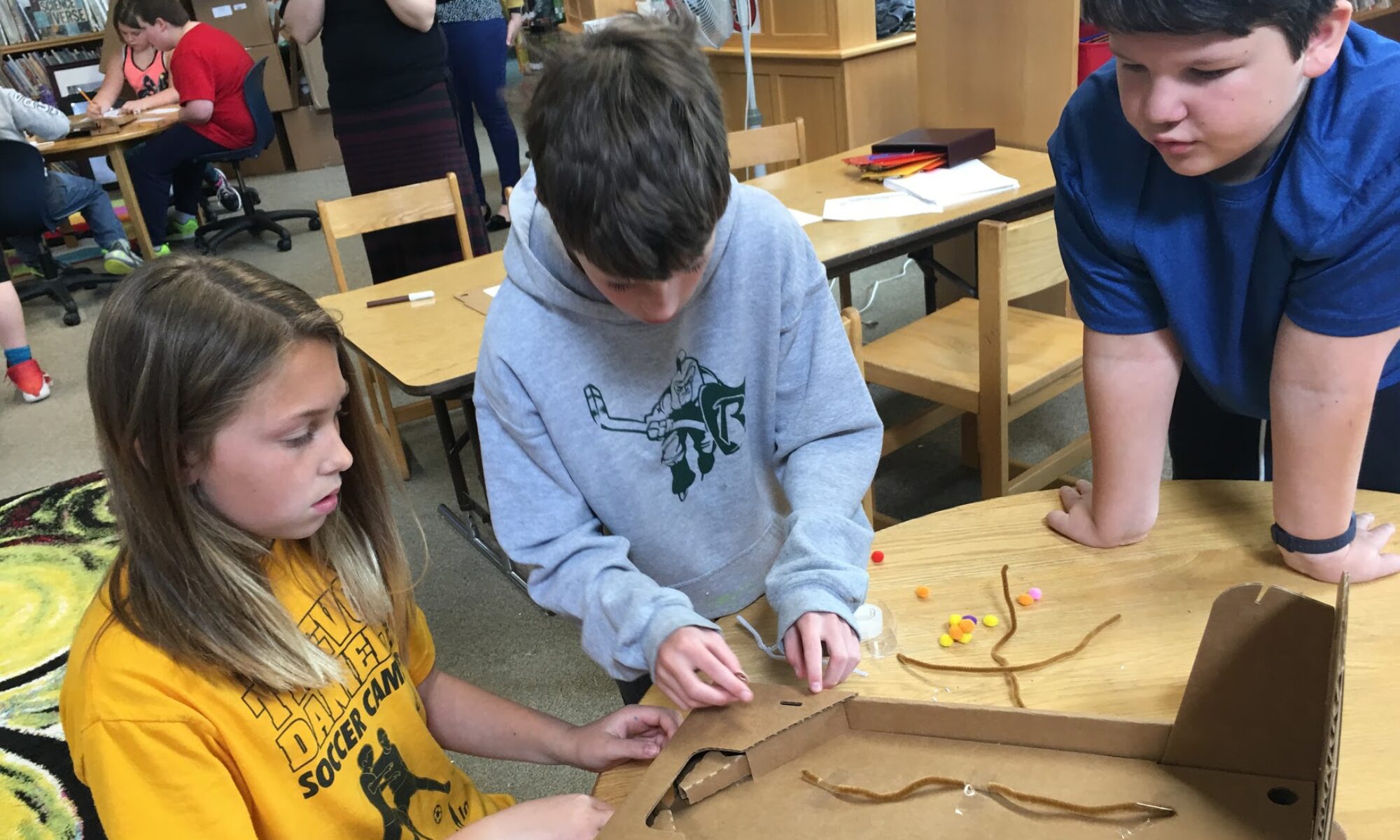

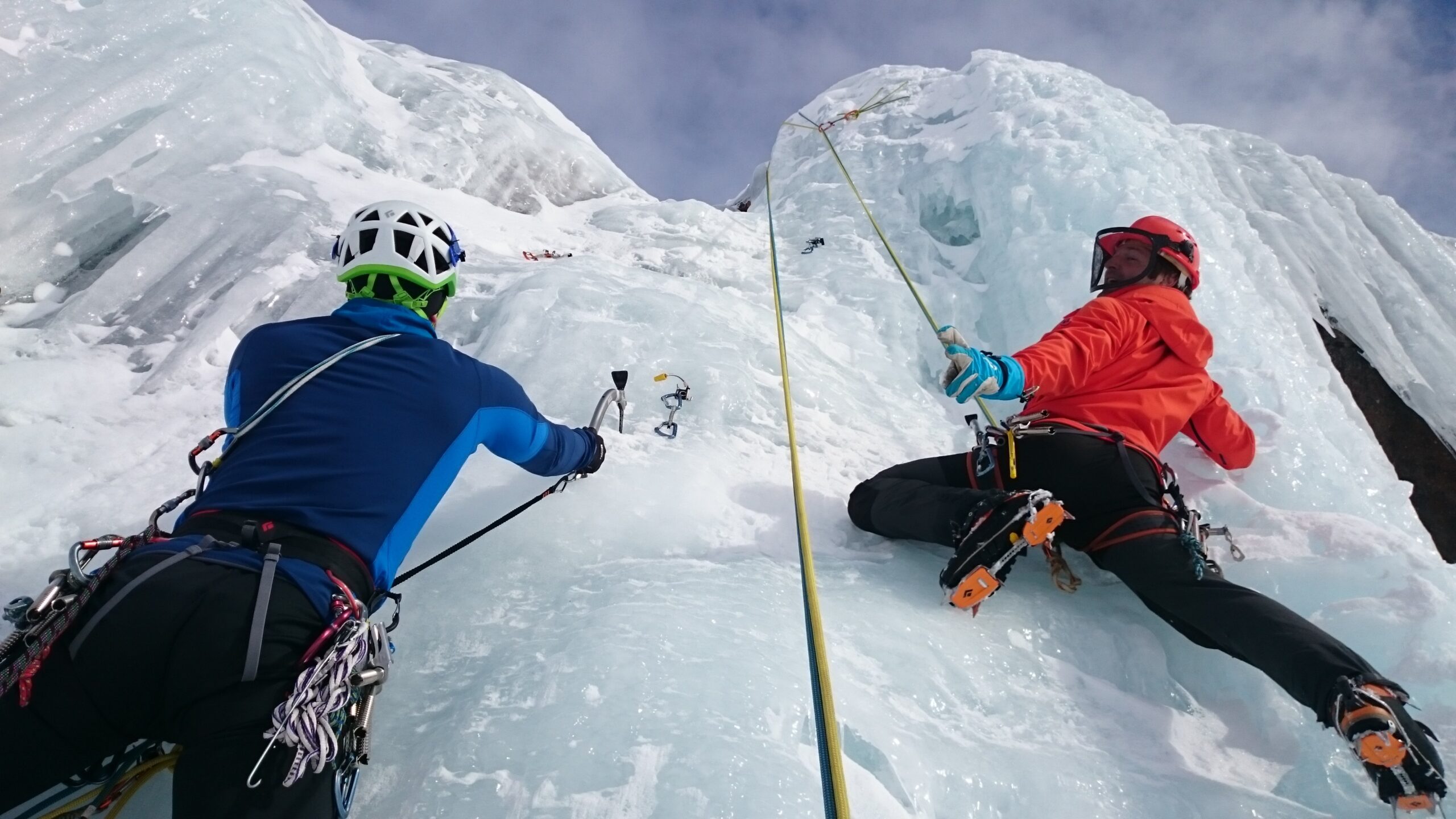
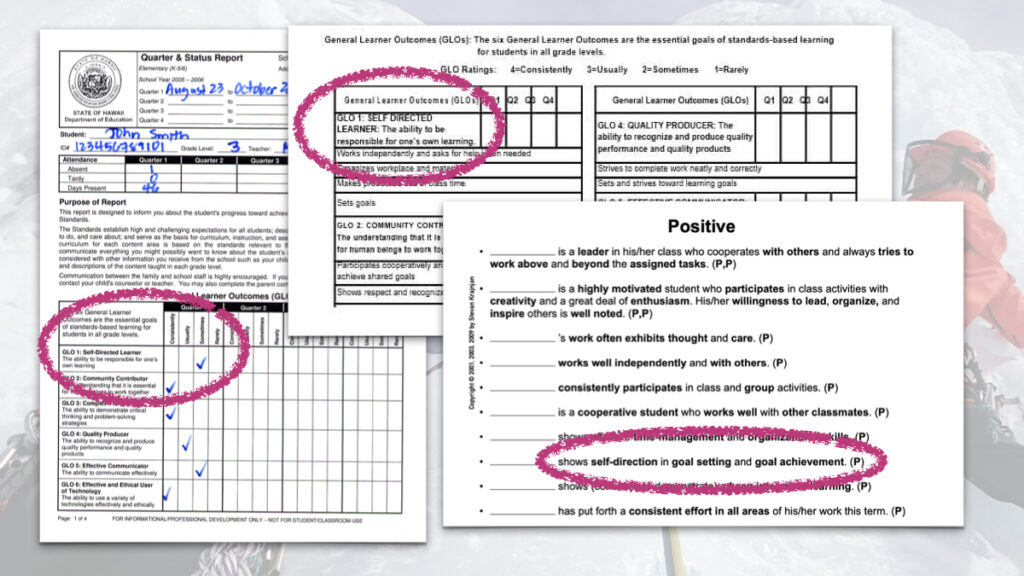
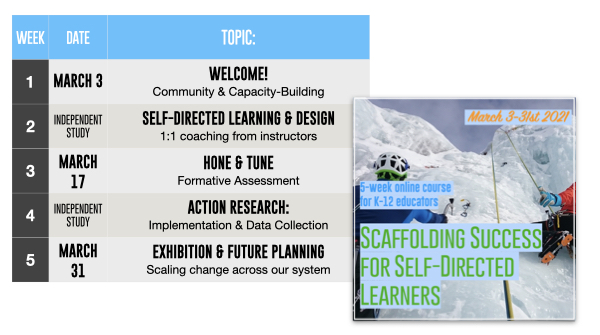
Hi there, its my first time commenting anywhere, when i read this post I thought i could also create a comment due to this sensible article.